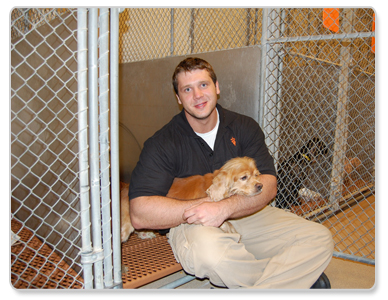OSU Veterinary Center Helps with Animal Rescue
Friday, September 25, 2009
(September 25, 2009 Stillwater, OK) – When the Payne County Sheriff’s office called
the Oklahoma State University Center for Veterinary Health Sciences on Thursday, Sept.
17, and asked if they could help with approximately 80 dogs and cats rescued from
a rural home, faculty, staff and students stepped up to help.
“The Sheriff’s Department alerted us that the animals were coming,” stated Dr. Michael
Lorenz, professor and dean of the veterinary center. “We called in veterinary technicians,
students and eight veterinarians who were not on call. The animals arrived in the
late evening.”
“I was on the phone with one of the ICU technicians and when I heard what was going
on, I came in to help,” said Dianne Hudson, RVT, VTS (Anesthesia).
Because the animals are the subject of legal action and serve as evidence, the intake
process included identifying and photographing each animal. Detailed records were
maintained for medical and legal purposes.
“We had eight teams each comprised of students/veterinary technicians and one faculty
veterinarian,” added Hudson.
“The animals were abused, neglected and poorly nourished,” said Dr. Mark Neer, director
of the veterinary center’s Boren Veterinary Medical Teaching Hospital. “While they
can’t be adopted until legally released, the plan was to put them in foster care.”
All animals were treated for internal and external parasites including sarcoptic mange,
which is a type of mange caused by mites burrowing in the skin especially of the head
and face. All adult dogs received Rabies vaccinations and puppies were vaccinated
for distemper, adenovirus, parvovirus and parainfluenza.
“It was absolutely amazing to see everyone swing into action,” stated Dr. Jill Brunker,
Small Animal Internal Medicine. “People were assigned to a station and we rotated
the animals through receiving, triage and treatment. Interns, residents, technicians
and fourth year veterinary students worked with one common goal—help these mistreated
animals.”
“We were able to do something on a large scale to help the animals and the community,”
said Dr. Todd Yeagley, Small Animal Internal Medicine and Surgery Intern. “It was
sad to see so many dogs that had suffered such horrible abuse.”
According to Hudson within two hours 80 animals had been examined.
“We were careful to do everything right so that the Sheriff’s Department would have
what they needed. Even after all the dogs had been processed, the students recognized
that the dogs needed to be bathed to help make them more comfortable and then we still
needed to clean up to get ready for the next day, so they stayed,” continued Hudson.
“The students and staff worked until the wee hours of the morning,” added Lorenz.
“Oklahomans can be extremely proud of the veterinary team. Despite the horrific scene,
the group performed at a high professional level. I am very proud of their dedication
and competence.”
“Dr. Neer and everyone at the veterinary hospital could not have been any kinder to
the animals or been more hospitable to the people who came to foster them,” stated
Garry McKinnis, Payne County Undersheriff. “I have 18 of them at my house. My wife
and I took four female Dachshunds and their puppies. We wanted to be sure they received
the right care until they are able to be adopted.”
Some of the dogs had to be soaked to loosen the debris matted in their hair and eventually
were clipped. According to Brunker, a single dose of medicine usually cures the sarcoptic
mange. The parasites should be gone in a few weeks followed by treatments at regular
intervals.
“I have seen dogs like that before but one at a time,” said Brandy Kastl, fourth year
veterinary student from Sapulpa, Okla. “Never so many at once—it was overwhelming.”
“It was pretty sad, especially the high number of dogs involved,” continued Matt Stone
of Springfield, Ill., also a fourth year veterinary student. “We were happy to help
the animals.”
“That’s what we do,” added Kastl.
Authorities at the veterinary center report that all dogs and cats involved in the
rescue have been placed in foster care as of Tuesday evening, Sept. 22, 2009.
The care of rescued dogs and cats is partially funded by the veterinary hospital’s
“Brittany Fund.” This fund was established to help seriously ill or traumatized pets
receive appropriate veterinary care when otherwise they would not. Donations are always
welcome and are acutely needed since funds are low at this time. Donations payable
to OSU Foundation with Brittany Fund noted in the memo section and mailed to Oklahoma
State University, 308 McElroy Hall, Stillwater, OK 74078 are truly appreciated. If
you would like more information on the Brittany Fund, call (405) 744-5630.
The Oklahoma State University Center for Veterinary Health Sciences is one of 28 veterinary
colleges in the United States and is fully accredited by the Council on Education
of the American Veterinary Medical Association. The center’s Boren Veterinary Medial
Teaching Hospital is open to the public and provides routine and specialized care
for small and large animals. It also offers 24-hour emergency care and is certified
by the American Animal Hospital Association. For more information, visit http://cvhs.okstate.edu
or call (405) 744-7000.

